Do you want a big dog or a small dog? That’s one of the first decisions you’ll need to make when choosing between a Doberman Pinscher and a Great Dane.
But size isn’t the only difference between these two breeds – in fact, quite a few things set them apart. Here’s a look at how Dobermans and Great Danes compare.
What are the Key Differences between Great Danes and Dobermans?
Size: Great Danes are one of the largest dog breeds, while Dobermans are considered a medium-sized breed.
Coat and grooming: Great Danes have a short, smooth coat, while Dobermans have a sleek, shiny coat that is easy to groom.
Temperament: Great Danes are known for being gentle giants, while Dobermans are known for being loyal and protective.
Activity level: Great Danes are relatively calm and relaxed, while Dobermans need plenty of exercise and stimulation.
Now that you know a little bit more about these two breeds, let’s take a closer look at each one, including their breeding histories.
Breeding History of Both Breeds
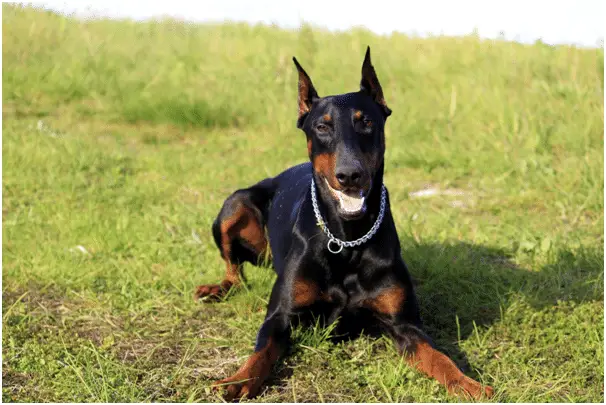
The Doberman Pinscher was bred in the late 19th century by a German tax collector named Louis Dobermann.
He wanted a dog that could serve as a loyal and fearless guard dog, so he crossed various German shepherd-type dogs with other breeds like the Great Dane, the Greyhound, and the Manchester Terrier.
On the other hand, the Great Dane has a much longer history – in fact, the breed dates back to ancient Greece.
These dogs were originally bred for hunting large game like wild boar, but they eventually became popular as companions and guardians.
Great Dane vs Doberman – Appearance
When it comes to appearance, both the Great Dane and the Doberman have a sleek, muscular build.
When it comes to head shape, the Doberman has a long, narrow head with pointed ears, while the Great Dane has a large, square head with floppy ears.

However, there are some other distinct differences in their appearance as outlined below.
Great Dane vs Doberman – Size Comparison
The most obvious difference between these two breeds is their size.
Dobermans are considered a medium-sized breed, while Great Danes are a gentle giant and one of the world’s most popular giant breed dogs.
The sheer size of a Great Dane can be quite remarkable. They can weigh up to 200 pounds, and their height can range from 28 to 34 inches tall at the shoulder.
In comparison, Dobermans weigh between 80 and 100 pounds and stand 24 to 28 inches tall.
Great Dane vs Doberman – Coat Type & Color
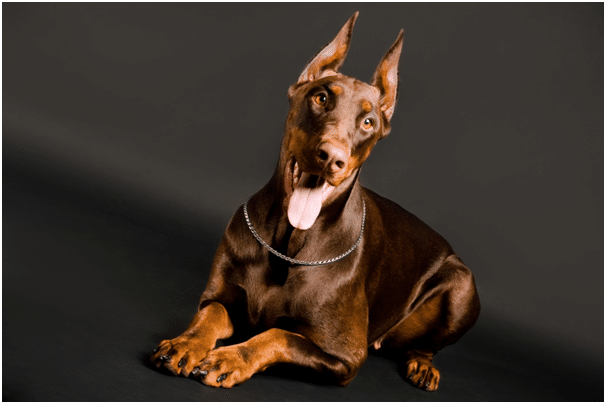
Another difference between these two breeds is their coat type and colors.
Dobermans have a short, smooth single coat that comes in black, blue, fawn, or red.
Great Danes also have a short double coat, but theirs is more of a glossy sheen. The undercoat of the Great Dane is soft and dense, providing insulation against the cold weather.
And while they can come in black or blue like the Doberman, they can also come in various colors, including brindle, fawn, mantle, merle, and harlequin.
Great Dane vs Doberman – Temperament
When it comes to temperament, both Great Danes and Dobermans are considered loyal and loving dogs. However, there are some differences in their personality.
Dobermans are often considered to be more reserved and aloof with strangers, while Great Danes are known for being more outgoing and friendly. Great Danes are also less likely to bark than Dobermans.
Both breeds are intelligent and trainable, although Dobermans are often considered to be more intelligent. And while Dobermans were bred as guard dogs, Great Danes were originally bred for hunting.
Great Dane vs Doberman – Aggression
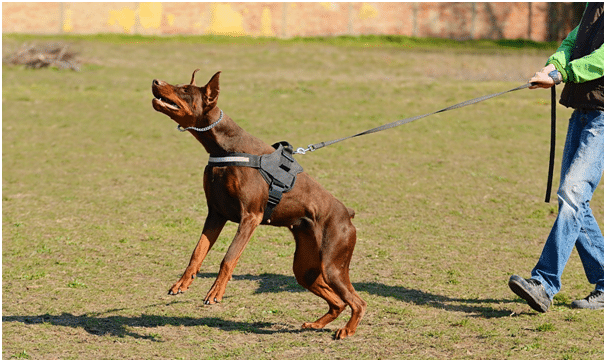
Dobermans are also more likely to show aggression than Great Danes. This is likely due to their history as guard dogs.
While Dobermans can make great family pets, they require early socialization and training to prevent them from being overly aggressive.
On the other hand, Great Danes are not known for being aggressive and are typically gentle giants. However, they can become extremely protective of their family if not properly trained.
This can be quite intimidating for some, as their immense size and overly protective nature are enough to scare off most people!
Great Dane vs Doberman – Strength
Due to their large size and muscular build, Great Danes are much stronger than Dobermans.
Their massive size means they can easily knock over small children and furniture and require a lot of space.
Dobermans are also strong dogs, but their smaller size makes them more manageable.
Great Dane vs Doberman – Bite Force
Interestingly, Dobermans have a stronger bite force than Great Danes. This is due to their smaller size and shorter muzzle.
Their powerful jaws can exert up to 600 pounds of pressure per square inch (PSI), which is significantly more than the average dog.
Great Danes have a bite force of about 320 PSI, which is still quite strong but not as powerful as the Doberman.
Are they Good with Children?
Dobermans are not recommended for homes with small children, as they can sometimes be quite aggressive.
Great Danes are typically gentle and loving dogs, but they require early socialization and training to prevent them from becoming overly protective.
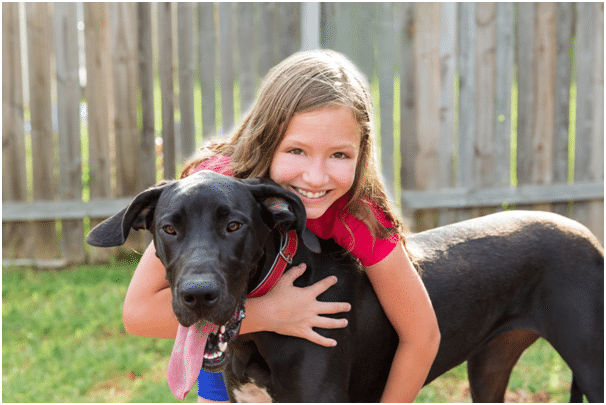
It is also important to note that both breeds are large and powerful dogs. This means they need a lot of space and can easily knock over small children and furniture.
Therefore, neither breed is really ideal for homes with small children or elderly people.
Great Danes are an affectionate dog breed, yet are better suited for families with older children who can handle their size and strength.
Dobermans also make great family pets, yet are better suited for experienced dog owners who can provide them with the training and socialization they need.
Novice dog owners and elderly people should avoid both breeds, as they can be quite challenging to train and manage.
Are they Good with Other Dogs?
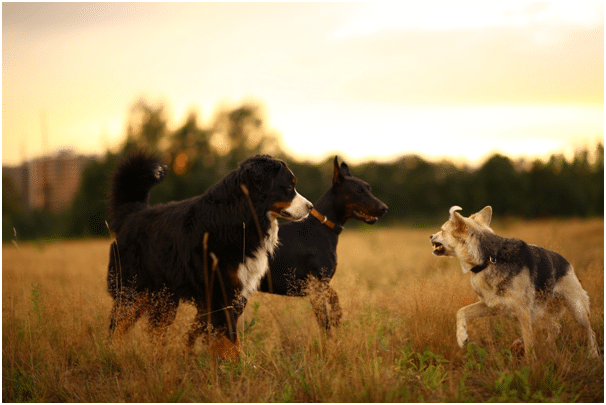
Dobermans can be aggressive towards other dogs, especially if they are not properly socialized. Great Danes are typically gentle and loving but can become quite protective of their family if not properly trained.
Both breeds need early socialization and training to prevent them from becoming overly aggressive. Great Danes are better suited for families with other dogs, as they are less likely to show aggression.
Great Dane vs Doberman – Training Needs
Due to their intelligence and trainability, both Great Danes and Dobermans can be easy to train. However, Dobermans are often considered to be easier to train than Great Danes.
This is likely due to their higher intelligence and more obedient nature.
Great Danes can be stubborn and independent, which can make training more difficult.
Obedience Training
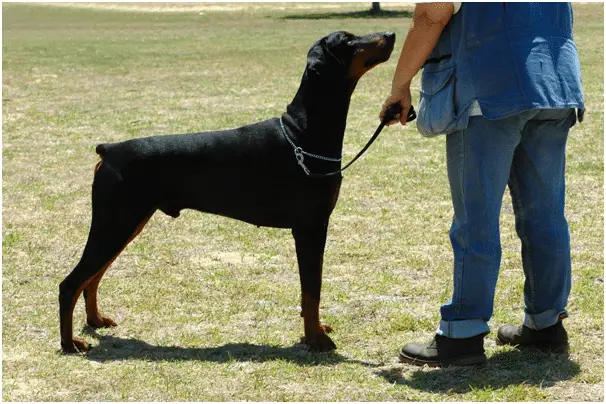
Both Great Danes and Dobermans will benefit from obedience training. This will help to instill good manners and obedience.
Proper training should start as soon as possible, with basic commands such as sit, down, stay and come.
Once your dog has mastered these commands, you can move on to more advanced tricks or behaviors.
Training sessions should be short, no more than 10 minutes at a time, and should be reinforcing for both you and your dog.
Be sure to use treats or praise as rewards for good behavior, and never punish your dog for making a mistake.
With patience and consistency, your dog will soon be a well-mannered companion.
Great Dane vs Doberman – Mental Stimulation
Both Great Danes and Dobermans are intelligent breeds that need mental stimulation to stay happy and healthy.
Boredom can lead to destructive and aggressive behavior, so it is important to keep your dog’s mind active with puzzles, toys and games.
One way to do this is to hide their favorite treat in a toy or around the house, and let them use their nose to find it.
Other games could include fetch or catch, where you throw a ball or Frisbee for them to chase after.
There are many different ways to keep your dog’s mind active, so find what works best for you and your pet. With a little effort, you can help your dog stay happy and healthy for years to come.
Great Dane vs Doberman – Intelligence
Great Danes and Dobermans are both intelligent breeds, but Dobermans are often considered to be more intelligent than Great Danes.
According to research, Dobermans are ranked as the 5th most intelligent dog breed, while Great Danes are ranked as the 23rd most intelligent dog breed.
This difference in intelligence can be attributed to the fact that Dobermans were bred for working purposes, while Great Danes were bred for companionship.
Dobermans were bred to be guard dogs, so they needed to be able to understand and follow commands. This required a higher level of intelligence than what was needed for Great Danes.
Great Dane vs Doberman – Exercise Needs
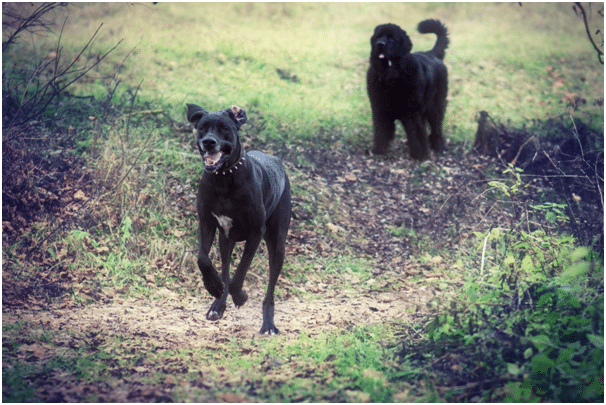
Both Great Danes and Dobermans need a moderate amount of exercise. They are not high-energy dogs, but they do need some daily activity to stay healthy and happy.
A good way to provide exercise for your dog is to take them on a daily walk or run. This will give them the chance to stretch their legs and get some fresh air.
You can also take them to a dog park, where they can play and socialize with other dogs. If you have a backyard, letting them run around and explore is also a great way to provide adequate exercise.
Find what works best for you and your pet, and be sure to provide some form of exercise on a daily basis.
Failure to do so can sometimes result in destructive behavior, including unexpected aggression or annoying chewing of household items and clothing.
Great Dane vs Doberman – Nutrition
Both breeds have different nutritional needs. Great Danes are a large breed, so they need food that is high in calories and protein. This will help them to maintain their size and energy level.
Dobermans are a medium-sized breed, so they do not need as many calories as Great Danes.
However, they are a working breed and need high protein food to help them maintain their muscle mass.
When choosing food for your dog, be sure to read the label carefully. Look for food that is appropriate for your dog’s size, age, and activity level.
This will ensure that your pet gets the nutrients they need to stay healthy and happy.
If you have any questions, be sure to talk to your veterinarian. They can help you choose the best food for your pet based on their individual needs.
Great Dane vs Doberman – Grooming
Shedding
Shedding is a natural process that helps dogs to get rid of old or damaged fur. Great Danes and Dobermans are both heavy shedders, so regular grooming is necessary to keep the shedding under control.
Brushing your dog on a daily basis is the best way to reduce shedding. This will help to remove loose hair before it has a chance to fall out on its own.
There are also special shampoos and conditioners that can help to reduce shedding. These products can be used once or twice a week to help keep your dog’s coat healthy and free of loose hair.
Drooling
Great Danes are known for their massive size, but they are also known for their drooling. This is because they have loose skin around their mouths, which allows saliva to collect and drip down.
Dobermans do not have this problem to the same extent as Great Danes. However, they can still drool when they are excited or nervous.
If drooling is a problem for you, there are some things you can do to help reduce it.
Wiping your dog’s face with a damp cloth after eating or drinking can help remove any saliva that has collected around their mouth.
You can also try feeding your dog smaller meals more often, instead of one large meal. This will help to reduce the amount of saliva that is produced.
Finally, you can talk to your veterinarian about medications that can help to reduce drooling.
These are typically only used in severe cases, but they can effectively reduce or eliminate the problem.
Adaptability to Weather
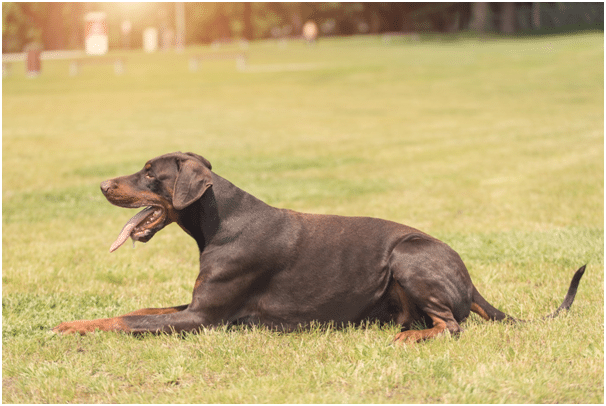
Great Danes and Dobermans have short coats, making them less tolerant of cold weather. If you live in an area with cold winters, you will need to take special care to keep your dog warm.
Dogs can get frostbite just like humans, so it is important to bring them inside if the temperature drops too low. If you must leave them outside, be sure to provide them with a warm, dry shelter that is out of the wind.
A dog house is not enough to keep your pet warm in winter weather. You will also need to provide them with a heated mat or blanket to lie on.
In warm weather conditions, it is important to keep your dog cool. They can get heat stroke just like humans, so be sure to provide them with plenty of shade and fresh water.
Avoid taking them for walks during the hottest part of the day, and never leave them in a parked car.
Talk to your veterinarian if you have any concerns about your dog’s ability to tolerate extreme weather conditions. They can provide you with additional tips and advice for keeping your pet safe and comfortable.
Health Issues
Great Danes and Dobermans are both susceptible to certain health problems. Some of these conditions are genetic, while others can develop later in life.
The most common health issues for Great Danes include:
- hip dysplasia,
- heart disease,
- bone disease
- retinal atrophy
- and various types of cancer.
Dobermans are also susceptible to these health conditions, as well as gastro intestinal conditions, and von Willebrand’s disease.
Some health problems can be prevented with proper care and nutrition.
For example, feeding your dog a healthy diet and regular exercise can help reduce their risk of developing obesity-related conditions such as heart disease.
Other health problems cannot be prevented but can be managed with treatment. For example, cancer can be treated with surgery, chemotherapy, and radiation.
Talk to your veterinarian if you are concerned about your dog’s health. They can provide you with information on how to keep your pet healthy and happy.
Life Expectancy
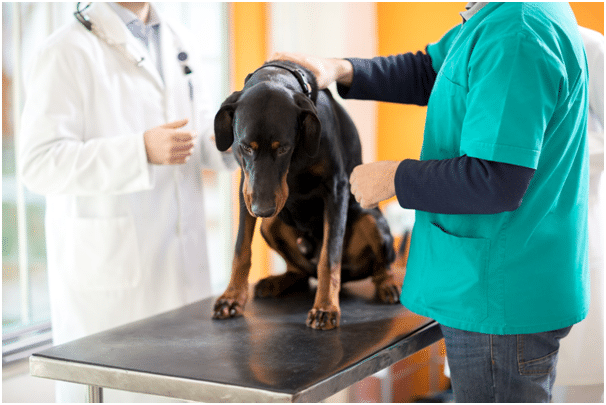
The life expectancy of Great Danes and Dobermans is about the same. Both breeds typically live for 8-10 years.
However, there are some factors that can affect a dog’s lifespan. For example, dogs that are fed a healthy diet and provided with regular exercise tend to live longer than those that are not.
Dogs that live in a home with multiple pets also tend to have a longer lifespan. This is because they are less likely to experience boredom or stress, which can lead to health problems.
Finally, dogs that are spayed or neutered tend to live longer than those that are not. This is because spaying or neutering can help to reduce the risk of certain health problems, such as cancer.
Talk to your veterinarian if you want your dog to live a long and healthy life. They can provide you with advice on how to care for your pet.
Puppy Prices
The average price of a Great Dane puppy is $500-$1,500. The average price of a Doberman puppy is $700-$2,000.
Prices can vary depending on the breeder, the parent’s lineage, and the availability of puppies.
For example, puppies that are from show lines or that have champion parents may be more expensive than those that are not.
If you are interested in purchasing a Great Dane or Doberman puppy, be sure to do your research.
This includes finding a reputable breeder and asking them questions about the parents, the puppies, and the price.
Remember, you get what you pay for. A cheaper puppy may have health or behavior problems that are expensive to fix. So, be sure to consider all of your options before making a decision.


